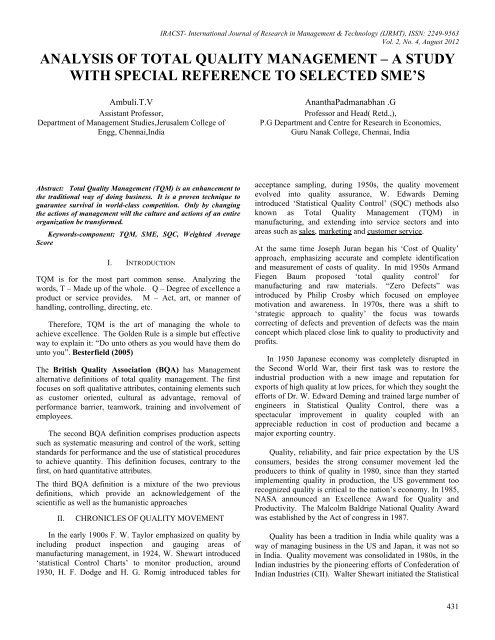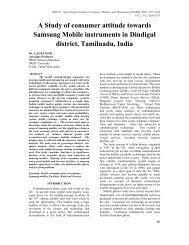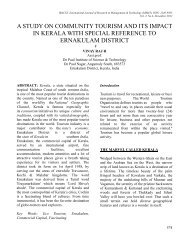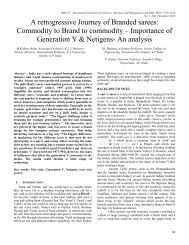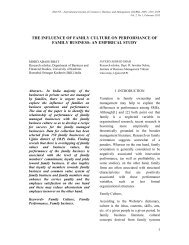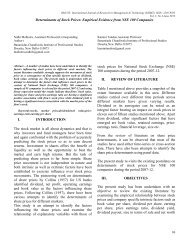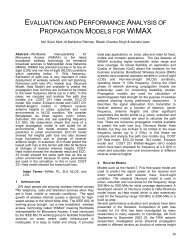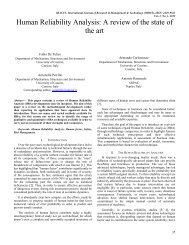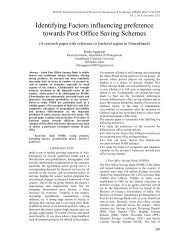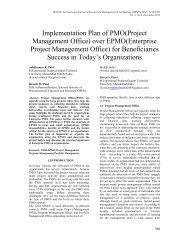ANALYSIS OF TOTAL QUALITY MANAGEMENT – A STUDY WITH ...
ANALYSIS OF TOTAL QUALITY MANAGEMENT – A STUDY WITH ...
ANALYSIS OF TOTAL QUALITY MANAGEMENT – A STUDY WITH ...
You also want an ePaper? Increase the reach of your titles
YUMPU automatically turns print PDFs into web optimized ePapers that Google loves.
IRACST- International Journal of Research in Management & Technology (IJRMT), ISSN: 2249-9563<br />
Vol. 2, No. 4, August 2012<br />
<strong>ANALYSIS</strong> <strong>OF</strong> <strong>TOTAL</strong> <strong>QUALITY</strong> <strong>MANAGEMENT</strong> – A <strong>STUDY</strong><br />
<strong>WITH</strong> SPECIAL REFERENCE TO SELECTED SME’S<br />
Ambuli.T.V<br />
Assistant Professor,<br />
Department of Management Studies,Jerusalem College of<br />
Engg, Chennai,India<br />
AnanthaPadmanabhan .G<br />
Professor and Head( Retd.,),<br />
P.G Department and Centre for Research in Economics,<br />
Guru Nanak College, Chennai, India<br />
Abstract: Total Quality Management (TQM) is an enhancement to<br />
the traditional way of doing business. It is a proven technique to<br />
guarantee survival in world-class competition. Only by changing<br />
the actions of management will the culture and actions of an entire<br />
organization be transformed.<br />
Keywords-component; TQM, SME, SQC, Weighted Average<br />
Score<br />
I. INTRODUCTION<br />
TQM is for the most part common sense. Analyzing the<br />
words, T – Made up of the whole. Q – Degree of excellence a<br />
product or service provides. M – Act, art, or manner of<br />
handling, controlling, directing, etc.<br />
Therefore, TQM is the art of managing the whole to<br />
achieve excellence. The Golden Rule is a simple but effective<br />
way to explain it: “Do unto others as you would have them do<br />
unto you”. Besterfield (2005)<br />
The British Quality Association (BQA) has Management<br />
alternative definitions of total quality management. The first<br />
focuses on soft qualitative attributes, containing elements such<br />
as customer oriented, cultural as advantage, removal of<br />
performance barrier, teamwork, training and involvement of<br />
employees.<br />
The second BQA definition comprises production aspects<br />
such as systematic measuring and control of the work, setting<br />
standards for performance and the use of statistical procedures<br />
to achieve quantity. This definition focuses, contrary to the<br />
first, on hard quantitative attributes.<br />
The third BQA definition is a mixture of the two previous<br />
definitions, which provide an acknowledgement of the<br />
scientific as well as the humanistic approaches<br />
II.<br />
CHRONICLES <strong>OF</strong> <strong>QUALITY</strong> MOVEMENT<br />
In the early 1900s F. W. Taylor emphasized on quality by<br />
including product inspection and gauging areas of<br />
manufacturing management, in 1924, W. Shewart introduced<br />
‘statistical Control Charts’ to monitor production, around<br />
1930, H. F. Dodge and H. G. Romig introduced tables for<br />
acceptance sampling, during 1950s, the quality movement<br />
evolved into quality assurance, W. Edwards Deming<br />
introduced ‘Statistical Quality Control’ (SQC) methods also<br />
known as Total Quality Management (TQM) in<br />
manufacturing, and extending into service sectors and into<br />
areas such as sales, marketing and customer service.<br />
At the same time Joseph Juran began his ‘Cost of Quality’<br />
approach, emphasizing accurate and complete identification<br />
and measurement of costs of quality. In mid 1950s Armand<br />
Fiegen Baum proposed ‘total quality control’ for<br />
manufacturing and raw materials. “Zero Defects” was<br />
introduced by Philip Crosby which focused on employee<br />
motivation and awareness. In 1970s, there was a shift to<br />
‘strategic approach to quality’ the focus was towards<br />
correcting of defects and prevention of defects was the main<br />
concept which placed close link to quality to productivity and<br />
profits.<br />
In 1950 Japanese economy was completely disrupted in<br />
the Second World War, their first task was to restore the<br />
industrial production with a new image and reputation for<br />
exports of high quality at low prices, for which they sought the<br />
efforts of Dr. W. Edward Deming and trained large number of<br />
engineers in Statistical Quality Control, there was a<br />
spectacular improvement in quality coupled with an<br />
appreciable reduction in cost of production and became a<br />
major exporting country.<br />
Quality, reliability, and fair price expectation by the US<br />
consumers, besides the strong consumer movement led the<br />
producers to think of quality in 1980, since than they started<br />
implementing quality in production, the US government too<br />
recognized quality is critical to the nation’s economy. In 1985,<br />
NASA announced an Excellence Award for Quality and<br />
Productivity. The Malcolm Baldrige National Quality Award<br />
was established by the Act of congress in 1987.<br />
Quality has been a tradition in India while quality was a<br />
way of managing business in the US and Japan, it was not so<br />
in India. Quality movement was consolidated in 1980s, in the<br />
Indian industries by the pioneering efforts of Confederation of<br />
Indian Industries (CII). Walter Shewart initiated the Statistical<br />
431
Quality Control (SQC) in 1947-48 through factory visits,<br />
discussions, and lectures, only in 1982 the quality circle was<br />
born, slowly Indian companies are accepting and introducing<br />
Total Quality Management (TQM), this is done with the<br />
initiative of the Confederation of Indian Industries (CII),<br />
Government of India. “National Quality Council for India”<br />
was promoted and integrated towards national movement<br />
annual “Quality Summit” is being organized annually to bring<br />
awareness to the Indian industries.<br />
Improvements in quality can lead directly to increased<br />
productivity and other benefits. Recent evidence shows that<br />
more and more corporations are recognizing the importance<br />
and necessity of quality improvement if they are to survive<br />
domestic and world-wide competition. In today’s Globalized<br />
economy quality management and control is recognized as the<br />
foundation of business competitiveness and is proactively<br />
integrated into all business. Many companies are trying very<br />
hard not only to satisfy their customer’s needs, this can only<br />
be achieved through cost reduction, improvement in product<br />
performance, increased customer satisfaction and a constant<br />
effort towards world class organizations. In order for<br />
companies to survive and grow in the future, it is essential that<br />
they deliver high quality goods and services.<br />
Many companies understand that TQM is necessary for<br />
them to remain competitive, retaining their market share and<br />
to be able to respond to changing competitive demand in today<br />
business world. Small and medium sized enterprises (SMEs),<br />
have been slow in adopting TQM when compared to large<br />
companies, very few had advanced. Globalization is driving<br />
companies toward quality as a necessary tool to compete<br />
successfully in worldwide markets. A direct outcome of this<br />
new emphasis is the philosophy of total quality management<br />
(TQM). In essence, TQM is a company-wide perspective that<br />
strives for customer satisfaction by seeking zero defects in<br />
products and services.<br />
III IMPORTANCE <strong>OF</strong> <strong>TOTAL</strong> <strong>QUALITY</strong><br />
<strong>MANAGEMENT</strong><br />
Implementing a total quality management system has<br />
become the preferred approach for improving quality and<br />
productivity in organizations. TQM, which has been adopted<br />
by leading industrial companies, understood that it is a<br />
participative system empowering all employees to take<br />
responsibility for improving quality within the organization.<br />
Instead of using traditional bureaucratic rule enforcement,<br />
TQM calls for a change in the corporate culture.<br />
Quality management is important to companies for a variety<br />
of reasons.<br />
1. Product quality<br />
IRACST- International Journal of Research in Management & Technology (IJRMT), ISSN: 2249-9563<br />
Vol. 2, No. 4, August 2012<br />
quality include: performance, reliability and<br />
durability.<br />
o Quality management ensures product<br />
quality. Some primary aspects of product<br />
2. Customer Satisfaction<br />
o Quality management ensures customer<br />
satisfaction.<br />
3. Increased Revenues<br />
o<br />
4. Reduce Waste<br />
o<br />
5. Teamwork<br />
o<br />
Quality products and services give the<br />
company a spotless reputation in the<br />
industry. This reputation allows the<br />
company to gain new customers and sell<br />
additional products and services to existing<br />
customers. A quality management program<br />
also removes inefficient processes within the<br />
system.<br />
A quality management program helps<br />
companies reduce waste. Companies that<br />
house inventory are paying for the storage,<br />
management and tracking of the inventory.<br />
The costs of having the inventory are built<br />
into the price of the product. Implementing a<br />
quality management program reduces the<br />
amount of inventory that costs the company<br />
money and occupies valuable space. Quality<br />
management means that there is a systematic<br />
approach to keeping inventories at<br />
acceptable levels without incurring waste.<br />
Work closely with suppliers to manage<br />
inventory using a Just-in-Time (JIT)<br />
philosophy. In short, a JIT inventory system<br />
helps the suppliers and manufacturer remain<br />
in close communication to become more<br />
responsive to the customer.<br />
Quality management systems force company<br />
departments to work as a team. Different<br />
areas of the company become reliant upon<br />
one another to produce a quality product that<br />
meets and exceeds the customers'<br />
expectations. A quality system incorporates<br />
measures that affect sales, finance,<br />
operations, customer service and marketing.<br />
IV IMPORTANCE <strong>OF</strong> SMALL AND MEDIUM<br />
ENTERPRISES IN THE ECONOMY<br />
Small and Medium-sized Enterprises (SMEs) are commonly<br />
recognized as one of the leading groups of economic activities<br />
globally, and pose enormous impacts on social issues. Most<br />
companies are currently categorized under SMEs and the<br />
goods and services that SMEs offer are diverse. Moreover,<br />
432
SMEs are suppliers for large enterprises. It is said that SMEs’<br />
performance, both positive and negative, in the Asia-Pacific<br />
region may be more influential than any other region in the<br />
world because of the rapid economic growth of the region<br />
today. SMEs’ share in total economic activity varies across<br />
countries and for a given country over time; they play a<br />
significant role in virtually every economy and represent a<br />
large segment of the private sector. Furthermore, firm size<br />
distribution within an economy is determined not only by<br />
prevailing consumption patterns, resource endowments and<br />
technology, but also by the degree of market competition, the<br />
legal and regulatory environment, the availability of credit, all<br />
of which are influenced<br />
NEED FOR <strong>QUALITY</strong><br />
Globalization is driving companies toward total quality<br />
management (TQM) as a necessary tool to compete<br />
successfully in worldwide markets. The total quality<br />
management (TQM) approach involves more than simply<br />
meeting traditional rejection rate standards. The end result of<br />
total quality management (TQM) is the efficient and effective<br />
use of all organizational processes in providing consistent<br />
quality at a competitive price. The total quality management<br />
(TQM) philosophy is a long-term endeavor that links people<br />
and processes in a system that alters the corporate culture to<br />
become one where quality is the core aspect of business<br />
strategy. In cultivating the total quality management (TQM)<br />
philosophy, strategic implementation must involve a focused<br />
effort on the part of every employee within the organization. It<br />
cannot be applied successfully on a piecemeal basis. Total<br />
quality management (TQM) requires that management, and<br />
eventually every member of the organization, commit to the<br />
need for continual improvement in the way work is<br />
accomplished. Business plans, strategies, and management<br />
actions require continual rethinking in order to develop a<br />
culture that reinforces the total quality management (TQM)<br />
perspective. The challenge is to develop a robust culture where<br />
the idea of quality improvement is not only widely understood<br />
across departments, but becomes a fundamental, deep-seated<br />
value within each functional area’s as well.<br />
Small and Medium Enterprises (SMEs) has a direct impact<br />
on the economic development in both the developed and<br />
developing countries. Small and medium sized enterprises<br />
(SME's) are at the centre of interest since the quality debate<br />
for several reasons. One is that larger organisations will not be<br />
able to improve the quality of their products, services and<br />
processes, unless their suppliers or the second-tier suppliers<br />
also grow to a higher level of quality maturity. It is believed<br />
that the adoption of total quality management (TQM) in Small<br />
and Medium Enterprises (SMEs) is a must, a gradual<br />
progression and selection of appropriate "quality tools and<br />
initiatives" as and when necessary, with the ultimate aim of<br />
continuous improvement in the organisations.<br />
STATEMENT <strong>OF</strong> THE PROBLEM<br />
IRACST- International Journal of Research in Management & Technology (IJRMT), ISSN: 2249-9563<br />
Vol. 2, No. 4, August 2012<br />
Total Quality Management (TQM) has become a frequently<br />
used term in discussions concerning quality. The international<br />
and national competitive environment is in a process of<br />
constant change by the globalisation of markets and the<br />
increased interdependence of economic agents. The role and<br />
contribution, which small organisations contribute to the<br />
economy, has become widely recognised. As all organisations,<br />
regardless of size and financial status, are involved in the<br />
quality revolution, issues concerning the quality development<br />
of small organisations are of major focus.<br />
V OBJECTIVES<br />
• To evaluate role of management in TQM<br />
implementation.<br />
• To analyze system factors towards the<br />
implementation of TQM<br />
METHODOLOGY<br />
The research strategy that the study will utilize is the<br />
descriptive method. A descriptive research intends to present<br />
facts concerning the nature and status of a situation, as it exists<br />
at the time of the study. In this study, primary and secondary<br />
research both are incorporated. The reason for this is to<br />
understand more about the issue and the different variables<br />
that involve with it. The primary data for the study is<br />
represented by the survey acquired from the respondents<br />
through a structured questionnaire.<br />
HYPOTHESIS<br />
• There is no significant difference in the mean<br />
agreeability scores on the opinion statements on<br />
TQM among the respondents.<br />
• There is no significant difference in the overall mean<br />
opinion score among different groups of respondents.<br />
• There is no significant gap between perception and<br />
adoption of Management<br />
leadership toward implementation of TQM<br />
OPINION ON TQM<br />
TABLE – 1 OPINION ON TQM<br />
433
It is seen from the above table that among the 10<br />
opinion statements on TQM, the mean agreeability score<br />
ranges between 3.616 to 3.912 and the score is higher in the<br />
statement S1 and is least in the statement S5.<br />
Null Hypothesis:<br />
There is no significant difference in the mean<br />
agreeability scores on the opinion statements on TQM among<br />
the respondents.<br />
ANOVA TABLE- A<br />
SOURCE DF S S M S F<br />
Between 9 62.180 6.909 6.745**<br />
groups<br />
Within 4989 5110.391 1.024<br />
groups<br />
**- Significant at 1 % level<br />
Since the F is significant the null hypothesis of no<br />
difference in the mean score on opinion statements on TQM<br />
among the respondents is rejected and there is significant<br />
difference in the mean scores among respondents. The mean<br />
scores among the respondents is furnished below:<br />
TABLE -2 MEAN OPINION SCORE<br />
ATTRIBUTES WEIGHTED AVERAGE RANK<br />
SCORE<br />
S1 3.912 1<br />
S2 3.892 2<br />
S3 3.842 5<br />
S4 3.708 7<br />
S5 3.616 9.5<br />
S6 3.616 9.5<br />
S7 3.888 3<br />
S8 3.656 8<br />
S9 3.762 6<br />
S10 3.846 4<br />
Source : Primary data<br />
IRACST- International Journal of Research in Management & Technology (IJRMT), ISSN: 2249-9563<br />
Vol. 2, No. 4, August 2012<br />
S.<br />
Weighted<br />
TQM<br />
No<br />
SA A N DA SDA average<br />
OPINION<br />
.<br />
score<br />
1. S1 159 195 100 35 11 3.912<br />
2. S2 167 202 53 66 12 3.892<br />
3. S3 164 177 99 36 24 3.842<br />
4. S4 112 192 140 50 6 3.708<br />
5. S5 110 187 127 53 23 3.616<br />
6. S6 99 194 134 62 11 3.616<br />
7. S7 128 210 145 12 5 3.888<br />
8. S8 110 177 150 57 6 3.656<br />
9. S9 107 228 120 29 16 3.762<br />
10. S10 150 207 75 50 17 3.846<br />
State Perce Adopti Mean Standard ‘t’-value<br />
ment ption on Differe Error of (Df=445)<br />
No<br />
nce Mean<br />
Difference<br />
S1 3.592 3.460 0.132 0.060 2.201*<br />
S2 3.874 3.401 0.473 0.053 8.994**<br />
S3 3.729 3.621 0.108 0.045 2.407*<br />
S4 3.776 3.536 0.240 0.043 5.532**<br />
S5 3.818 3.729 0.090 0.051 1.772<br />
S6 3.469 3.587 -0.119 0.048 -2.456*<br />
TABLE- 3 <strong>MANAGEMENT</strong> LEADERSHIP<br />
Statem Percepti Adopt Mean Standard ‘t’-<br />
ent No on ion Differe Error of value<br />
nce Mean<br />
Difference<br />
1 3.509 3.622 -0.113 0.059 -1.91<br />
2 3.818 3.592 0.226 0.055 4.11**<br />
3 3.516 3.558 -0.041 0.038 -1.10<br />
4 3.516 3.304 0.212 0.048 4.38**<br />
The above table showed that among the 10 opinion<br />
statements on TQM S1-S10, S1 has secured higher mean score<br />
and stood at top, followed by statement S2 secured higher<br />
mean score and stood at second and statement S7 has secured<br />
next higher score and stood at third and finally S5 & S6 have<br />
secured least score and stood at last.<br />
VI PERCEPTION AND ADOPTION <strong>OF</strong> TQM<br />
Using the paired‘t’ test, the gap analysis is performed<br />
between perception and adoption of TQM among the<br />
respondents and the results are presented in the tables given<br />
below:<br />
**-Significant at 1 % level.<br />
*-Significant at 5 % level<br />
It is seen from the above table that among the six<br />
statements about Management leadership all the statements<br />
except S5, there is significant gap between perception and<br />
adoption of Management leadership and in S1 to S4 the<br />
perception score is higher and in S6 it is lesser than adoption<br />
score.<br />
TABLE- 4 SYSTEMS & PROCESS<br />
**-Significant at 1 % level.<br />
It is seen from the above table that among the four<br />
statements about Systems & Process the statements S2 and<br />
S5, there is significant gap between perception and adoption of<br />
Systems & Process and the perception score is higher than<br />
adoption score.<br />
Suggestions and conclusion<br />
434
• Among the general opinions on TQM, the mean<br />
agreeability score range between 3.616 to 3.912 and<br />
it is higher in the statement S1 and is least in the<br />
statement S5<br />
• .There is significant gap between perception and<br />
adoption of Management leadership and in S1 to S4<br />
the perception score is higher and in S6 it is lesser<br />
than adoption score..There is no significant gap<br />
between perception and adoption of Management<br />
leadership and the perception score is on par with<br />
adoption score.<br />
• .There is significant gap between perception and<br />
adoption of Management leadership and in S2 and<br />
S3 the perception score is higher and in S1 it is lesser<br />
than adoption score.<br />
• There is significant gap between perception and<br />
adoption of Systems & Process and the perception<br />
score is higher than adoption score.<br />
BIBLIOGRAPHY<br />
[1] Armand Fiegen Baum Total Quality Management, third edition, Pearson<br />
Education, Inc. Delhi, 2005.<br />
[2] Al-Nofal A., Professor Zairi M., Dr Ahmed A. M. Critical Factors of<br />
TQM: An international Comparative Benchmarking Analysis, European<br />
Centre for Best Management Practice, 2010<br />
[3] Besterfield. H Dale, Michna-Carol Besterfield, Besterfield Glen H., Sacre-<br />
Mary Besterfield, Total Quality Management, third edition, Pearson<br />
Education, Inc. Delhi, 2005.<br />
[4] BhatShridhara. K, Total Quality Management, Himalaya Publishing<br />
House, New Delhi, 2010.<br />
[5] Changizvalmohammadi,MandanaKhodapanahi,International Journal Of<br />
Academic Research Vol. 3. No. 1. January, 2011, Part II, Pp.601-609<br />
[6] Creswell, J.. Research design: Qualitative and quantitative approaches.<br />
London: Sage 1994.<br />
[7] Chin a, K.-F. Pun b, Y. Xu, J.S.F. Chan. Technovation, 2002; Pp.707-715.<br />
[8] Best,1970 Total Quality Management, third edition, Pearson Education,<br />
Inc. Delhi, 2005.<br />
[9] Dale, B. G., Boaden R. J. and Lascelles, D. M. Managing Quality, 2nd<br />
Edn. Prentice Hall, 1994.<br />
[10] HF Dodge and ).Walter shewart Managing Quality, 2nd Edn. Prentice<br />
Hall, 1994.<br />
IRACST- International Journal of Research in Management & Technology (IJRMT), ISSN: 2249-9563<br />
Vol. 2, No. 4, August 2012<br />
[11] Edward reference Managing Quality, 2nd Edn. Prentice Hall, 1994.<br />
[12] Faisal Talib, ZillurRahman, M.N. Qureshi, International Journal of<br />
Business, Management and Social Sciences, Vol. 1, No. 1, 2010, Pp. 113-128.<br />
[13] Hill Wilkinson Managing Quality.2nd Edn.Prentice Hall, 1994.<br />
[14] Hongyi Sun And Tsz-Kit Cheng, (2002), International Small Business<br />
Journal, SAGE Publications (London, Thousand Oaks and New Delhi)<br />
2002,Vol 20(4), Pp.421-442.<br />
[15] John Watson, Ralph Kober, Juliana Ng, ThanesvarySubramaniam, 16th<br />
Annual Conference of Small Enterprise Association of Australia and New<br />
Zealand,28 September - 1 October2003, Pp.1-9.<br />
[16] Mittal Deepak, VineetSingla, Comparison of TQM success factors<br />
in northern India in manufacturing and service industries, International<br />
journal of engineering science & technology (IJESI) ISSN-0975-5462,<br />
Vol,3,No.2 Feb 2011 Pp. 1365-1368.<br />
[17] Mustapha MohamadReeduan, MohdShaladdinMuda, Fauziah Abu Hasan,<br />
International Journal of Humanities and Social Science Vol. 1 No. 2;<br />
February, 2011, Pp.118-122.<br />
[18] NielsBrynnum, Total Quality Management - Aspects of Implementation<br />
and Human Resource, MBA Thesis, Blekinge Institute Of Technology, 2006,<br />
Pp-1-66.<br />
[19] Ou Chin .S, Fang C. Liu, Yu C. Hung, David C. Yen, Proceedings of the<br />
11th Annual Conference of Asia Pacific Decision Sciences Institute Hong<br />
Kong, June 14-18, 2006, pp. 214-217.<br />
[20] Oakland Managing Quality, 2nd Edn.Prentice Hall, 1994.<br />
[21] Powell Thomas C., Total quality management as competitive advantage:<br />
A review and empirical study, willey online library, 2006<br />
[22] Salaheldin Ismail Salaheldin, Critical linkages among TQM factor and<br />
business results, International Journal of Productivity and Performance<br />
Management Vol. 58 No. 3, 2009.<br />
[23] Sila Ismail, Journal of Operations ManagementVolume 25, Issue 1,<br />
January 2007, Pages 83-109<br />
[24] Singh Rajesh Kr ( 2011)Analyzing the interaction of factors for success<br />
of total quality management in SMEs, Asian Journal on Quality Volume: 12,<br />
Issue: 1, Pages: 6-19 (2011)<br />
[25] Saunders et. al, Managing Quality, 2nd Edn. Prentice Hall, 1994.<br />
[26] Taylor.F.W Managing Quality, 2nd Edn.Prentice Hall, 1994.<br />
[27] Tarí Juan José, José Francisco Molina and Juan Luis Castejón, European<br />
Journal of Operational Research,Vol. 183,No.2, Nov .2007 Pp. 483-501<br />
[28] Walter Shewart Managing Quality, 2nd Edn.Prentice Hall, 1994.<br />
435


